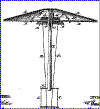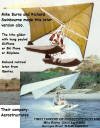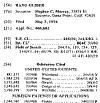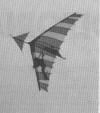|
For posting anywhere: The Gold Circle of Flex-Wing Hang Glider
world | Most recent
edit:
Friday April 25, 2014
http://energykitesystems.net/WHGA/FlexWingHangGliderGoldAirAward.html
NEWS RELEASE ... a dynamic document with growing awardee
inclusion:
Flex-Wing Hang Glider
The World
Hang Gliding Association has
awarded,
Differently, the WHGA has this Flex-Wing Hang Glider Gold Air Award that will be open to historical findings about the flex-wing hang glider, perhaps battened. Enjoy the history of each awardee's personal story and adventure. See the emptiness of the hoax, but see the joy of making and flying. The FAI, GH, and JD should know that they will probably be forgiven by the hang gliding community for the rash unsound flattening of the otherwise rich history of the public-domain flex-wing hang glider arts, when they recant and rewrite their untenable texts for some fresh version with open and fair apologies. The great sport of hang gliding has a big joyous heart and it seems to recognize how huge is the excitement that many have about hang gliding; when someone gets so excited that they wish to claim what belongs to another, then such matter will be brought to light by those who care about the face of hang gliding; there is no need to flatten a giant great scene into a one-point untenable.
Let us know if the WHGA is to add other names to the flex-wing flow fit for the Technical note: The branch of hang gliding that has focus on highly taut fabric surfaces do form cause for a different category for awards other than this above award from WHGA. Specific flexible-sailed hang glider designing is not a done deal; innovations continue; and leaders in such will be considered for the Flex-Wing Hang Glider Gold Air Award. We thank all those who have been working diligently on matters of hang glider history. |
|

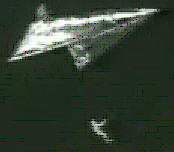


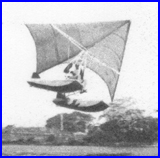 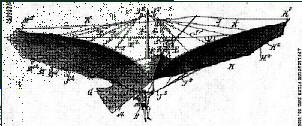 

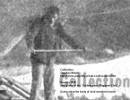

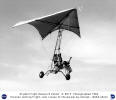
  |
|
| On May 20, 2013, John Worth became an awardee in the World Hang Gliding Association's Flex-Wing Hang Glider Gold Air Award, shared with others who contributed to the mid-1900s renaissance in hang gliding. John presented refreshingly the public-domain A-frame for control of the position of hung payloads combined with four-boom flex-wing within the Rogallo-NASA-Ryan environment. | |
|
Most people do not recognize "back side of the power curve". if you fly behind
the backside of the power curve you are you a parachutist or in a standard
aircraft of normal configuration you are well stalled. The aircraft shown was
flown behind the power curve, at first, and it would be considered a kite.
However, I never considered it as flight until I ran in essentially-no-wind
conditions thru the backside to gain true flight. I was never towed, though I
attempted to fly a normal configuration hang glider, so it was well in my mind.
Dickenson developed the configuration thru towed flight. The advantages of towed
flight were graphic when I went to powered flight, although propulsion was via
installed engine, not a tow. Dickenson actually flew when I was in the
development of the powered craft some 4 years later. ~Barry Hill Palmer
~May 20, 2013 [[Barry Hill Palmer put a line of credit for his
doings to an encounter with either Charles Richards or someone working with
Richards. ED.]] Barry noted further today: "My main
accomplishment is going thru the backside of the power curve, just like a large
bird, which is unusual even today." [[Others have highly valued his
having first built and tried a non-flex-wing hang glider and then built seven or
eight versions of the four-boom flex-wing hang glider.]] He
makes a technical note about one of several schemes constructed that forms a
special simplicity:
"the original attempt was to
eliminate the need for a kingpost by using a rigid spreader that folded in the
middle. Note that I load the central boom two places, which avoids fore and aft
wires." 1962. He went on to be an early private citizen to
have an ultralight powered flex-wing using the four-boom hang glider wing
foundations; he registered such craft with the F.A.A. Trike: 1967 "Completed in March of 1967. This is possibly the earliest example of a trike." ~BHP Notice that BHP had completely developed hang gliders; each was completely developed; and then he decided to completely develop another version; he was done with one version and went on to the next. |
|
| James Hobson had a completely developed hang glider in 1962 also; he shared his project in Sport Aviation magazine to the huge Experimental Aircraft audience. Then in 1962 he showed is flex-wing hang glider on national television in the Lawrence Welk Show. An official memorial in 2013 in California will be held for him on Otto Lilienthal's birthday. Jim passed on April 26, 2013. He was director-produced for the Lawrence Welk Shows. Jim used the A-frame also. | |
| Many people from many countries completed and flew their flex-wing hang gliders. | |
| In 1960-62 John Worth flew many sizes of the flex-wing hang glider with many different payloads. He had the super simple A-frame from the public-domain arts (e.g. in hang gliding in first decade of 1900s). Rogallo would visit John Worth on the flying field. Photo in collection above. His flying was mostly by passive means a RC means; his craft gave a simple template for the wing that would be found throughout hang gliding for ten-plus years, including the A-frame for controlling position of the payloads of human or not. | |
|
|
|
| Richard "Dick" Swinbourne (R.I.P., d: 55 years old) | |
Pierre Aubert
|
|
|
http://tinyurl.com/EarlyTrikeFlexWing First Flights in the Winged
Tricycle Posted by Amy Teitel 3:10 PM on Mar 07, 2012 |
|
| Gottlob Espenlaub hangglider.jpg (file) circa 1922 http://upload.wikimedia.org/wikipedia/commons/a/a3/Gottlob_Espenlaub_hangglider.jpg | |
|
|
|
Our local crafting is often a real novel thing for oneself. Such may be a very exciting time. The solving of challenges is filled with our personal creativity; we may often feel we are inventing, and indeed we are, but of a local personal sort which is very important! Rashly publicly stating that one is THE global mechanical inventor of such or so will often bite sour and cost culture energy to combat involved unearned badge; it is recommended to do robust research before making rash global claims. |
|
| Various names for the mechanical family: Flexible wings, steerable parachutes, paragliders, canopy hang gliders, stiffened canopy glider, gliding kite systems, Rogallo wings, parawings, para-wings, gliding canopies, gliding parachutes, parachutes, Lee & Darrah evolutes, Rogallo evolutes, Barish evolutes, Jalbert evolutes, high-L/D parachutes, kite-framed hang gliders, Prentice wings, Worth Wings, Paresev wings, recovery wings, Lavezzari wings, limp Rogallo wings, stiffened Rogallo wings, etc. ... many more. | |
|
Quiz:
Did someone in 1962 build and show a "Rogallo Hang Glider" to two significant large viewing audiences, both of which had international factions? Answer: Yes. More than one person. But James Hobson suffices. Experimental Aircraft Association's magazine Sport Aviation had some non-USA readership. Lawrence Welk Show ... national USA television popular show had some non-USA viewers. Editor of Sport Aviation wrote without a pause: "Rogallo Wing Hang Glider" in featuring Jim Hobson's foot-launch hang glider that had triangle control frame. |
|
Positive players, but off target:
|
|
|
Attn: President of FAI.
|
|
|
